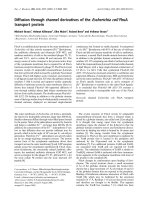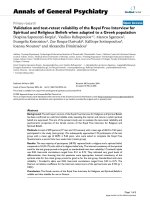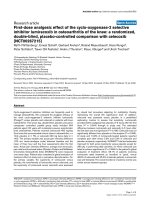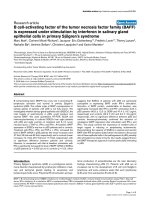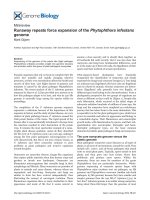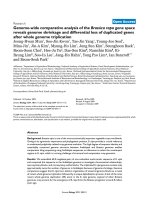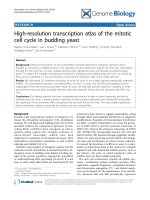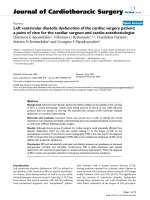Báo cáo y học: "Validation and test-retest reliability of the Royal Free Interview for Spiritual and Religious Beliefs when adapted to a Greek population" doc
Bạn đang xem bản rút gọn của tài liệu. Xem và tải ngay bản đầy đủ của tài liệu tại đây (271.17 KB, 8 trang )
BioMed Central
Page 1 of 8
(page number not for citation purposes)
Annals of General Psychiatry
Open Access
Primary research
Validation and test-retest reliability of the Royal Free Interview for
Spiritual and Religious Beliefs when adapted to a Greek population
Despina Sapountzi-Krepia
1
, Vasilios Raftopoulos*
2
, Marcos Sgantzos
3
,
Evangelia Kotrotsiou
4
, Zoe Roupa-Darivaki
4
, Kalliope Sotiropoulou
5
,
Ioanna Ntourou
6
and Alexandra Dimitriadou
1
Address:
1
Nursing Department, Technological Educational Institute of Thessaloniki, Thessaloniki, Greece,
2
Hellenic Centre for Infectious Diseases
Control, Athens, Greece,
3
Medical School, University of Thessaly, Larissa, Greece,
4
Nursing Department, Technological Educational Institute of
Larissa, Larissa, Greece,
5
Health Services of The National Bank of Greece, Athens, Greece and
6
University of Cologne, Faculty of Remedial Sciences,
Cologne, Germany
Email: Despina Sapountzi-Krepia - ; Vasilios Raftopoulos* - ; Marcos Sgantzos - ;
Evangelia Kotrotsiou - ; Zoe Roupa-Darivaki - ; Kalliope Sotiropoulou - ;
Ioanna Ntourou - ; Alexandra Dimitriadou -
* Corresponding author
Abstract
Background: The self-report version of the Royal Free Interview for Religious and Spiritual Beliefs
has been confirmed as a valid and reliable scale, assessing the manner and nature in which spiritual
beliefs are expressed. The aim of the present study was to evaluate the test-retest reliability and
psychometric properties of the Greek version of the Royal Free Interview for Religious and
Spiritual Beliefs.
Methods: A total of 209 persons (77 men and 132 women) with a mean age of 28.33 ± 9.44 years
participated in the study (test group). We subsequently approached 139 participants of the test
group with a mean age of 28.93 ± 9.60 years, who were asked to complete the Royal Free
Questionnaire a second time two weeks later (retest group).
Results: The vast majority of participants (58.9%) reported both a religious and a spiritual belief,
compared to 52 (25.1%) who told of a religious belief only. The internal consistency of the spiritual
scale for the test group proved to be good, as standardized inter-item reliability / Cronbach's alpha
was 0.83. Item-total correlations ranged from 0.51 to 0.73. They indicated very good levels of
differentiation, thus showing that the questions were appropriate. Internal consistency of the
spiritual scale for the retest group proved as good as for the test group. Standardized inter-item
reliability / Cronbach's alpha was 0.84. Item-total correlations ranged from 0.52 to 0.75. The
Pearson correlation coefficient for the total test-retest score of the spiritual scale was 0.754 (p <
0.001).
Conclusion: The Greek version of the Royal Free Interview for Religious and Spiritual Beliefs is
reliable and thus suitable for use in Greece.
Published: 04 March 2005
Annals of General Psychiatry 2005, 4:6 doi:10.1186/1744-859X-4-6
Received: 08 December 2004
Accepted: 04 March 2005
This article is available from: />© 2005 Sapountzi-Krepia et al; licensee BioMed Central Ltd.
This is an Open Access article distributed under the terms of the Creative Commons Attribution License ( />),
which permits unrestricted use, distribution, and reproduction in any medium, provided the original work is properly cited.
Annals of General Psychiatry 2005, 4:6 />Page 2 of 8
(page number not for citation purposes)
Background
Religious faith, spirituality and spiritual beliefs were rarely
discussed in the psychological or medical literature of the
'80s [1,2]. However, over the past decade an increasing
interest on the part of health care professionals in spiritu-
ality and spiritual care emerged, and related articles were
frequently published in medical and nursing journals [3-
8]. Religious faith and spirituality are now widely recog-
nized as important components of subjective human
wellness [9], of health care outcomes [10-14], of holistic
nursing care [15,16] and of the quality of hospital care
[17-19].
Nevertheless, the terms spirituality and religiousness have
been used in different ways by different authors, some-
times interchangeably because of the elusiveness of both
concepts. Narayanasamy argues that the lack of any
authoritative definition of these two terms has resulted in
a multiple definition and hence in the confusion sur-
rounding these concepts [20]. Furthermore, Mokuau et al.
aptly state: " the difficulties in developing standardized defi-
nitions and measures relate to varying interpretations of reli-
giousness and spirituality " and they stress that the
potential for providing quality care that integrates reli-
giousness and spirituality to a large extent depends upon
the development of measures that are at least psychomet-
rically sound [21].
Studies on religiousness, spirituality and spiritual care are
rare in Greece [17,22] and this may be the reason for the
present lack of a valid instrument. Sapountzi et al. men-
tion that " the lack of valid instruments is a widespread phe-
nomenon, concerning not only Greece but rather all non-
English speaking countries, owing to the fact that in this day
and age, English is the language of science, just as Greek was
in biblical times " [23].
In 1995 King et al. developed a scale, "The Royal Free
Interview for Religious and Spiritual Beliefs", in order to
evaluate religious and spiritual beliefs in a variety of pop-
ulations. Some years later, this scale was modified in order
to make it more functional [24,25]. The Royal Free Inter-
view for Religious and Spiritual Beliefs is a valid and reli-
able scale; in the English version [24], it is short and
simple and can be easily completed by most people.
Moreover, it focuses on the strength and the consequences
of faith, rather than on the specific nature of each belief
and as King et al. stress, the " interview was designed specif-
ically to avoid a focus on any one religious system or type of spir-
itual belief and thus comparisons were impossible to make "
[24].
At the time that The Royal Free Interview for Religious and
Spiritual Beliefs was published, the researchers of the
present paper were looking for an instrument capable of
measuring spirituality and religiousness in the Greek pop-
ulation [24]. Following careful consideration, they
decided to translate an already valid instrument instead of
developing a new one, choosing a European rather than
an American one, because they believe that although cul-
tural differences exist among European populations, they
also share many common cultural issues. In addition, tak-
ing into account that the vast majority of the population
living in Greece belongs to the Greek Orthodox Church, it
was desirable to find a scale designed specifically to avoid
a focus on any one religious system or type of spiritual
belief. The Royal Free Interview for Religious and Spiritual
Beliefs fulfilled most of the criteria set, and therefore the
researchers approached Professor King, asking for his per-
mission to translate the scale into the Greek language and
validate it. After obtaining written permission, the Royal
Free Interview for Religious and Spiritual Beliefs was
translated into Greek in 2003 [23]. In a second stage, the
research team continued evaluating the psychometric
properties of the scale. Let us point out that as a result of
extensive discussions among the research team and with
other researchers, we decided to revise the question "How
would you describe yourself? (tick one or more)". More
precisely, the modified question in the Greek version
asked participants to tick a specific part of Greece as their
place of origin. Given that over the past twenty years,
Greece has been faced with immigration from the Balkan
countries and the former USSR, the question was adapted
to include these newcomers' origin as well. The question
was thus revised, and instead of asking respondents to
indicate specific parts of Greece as their place of origin,
they are now requested to indicate their origin from an
international perspective. The modification was made in
order to make the question suitable for people from a
variety of ethnic backgrounds living in contemporary
Greece.
This paper reports on test – retest reliability and the psy-
chometric properties of the Greek version of the Royal
Free Interview for Spiritual and Religious Beliefs.
Methods
Cross-cultural validation of an existing scale, such as the
Royal Free Interview for Spiritual and Religious Beliefs,
has the great advantage of avoiding the initial stages of
development of a new questionnaire, which is a lengthy
process [26]. Furthermore, translation and adaptation of
a scale into different languages makes it possible to use
the questionnaires in comparative international multi-
center studies. This is why we decided first to translate, re-
translate and then proceed to check the validity, reliability
and psychometric properties of the scale for a Greek pop-
ulation [27-29].
Annals of General Psychiatry 2005, 4:6 />Page 3 of 8
(page number not for citation purposes)
The translation and the cultural adaptation of the Royal
Free Interview for Spiritual and Religious Beliefs was car-
ried out at an early stage [23]. A panel of experts who were
also bilinguals was requested to translate the English ver-
sion of the Royal Free questionnaire. Furthermore, in
order to assess the linguistic accuracy of the translated
instrument, a pilot study using bilingual persons was car-
ried out. Details related to the translation and adaptation
of the Royal Free questionnaire for spiritual and religious
beliefs are mentioned elsewhere [23].
Test – Retest
To evaluate the stability of a translated instrument, it is
recommended that it be tested in the target culture based
on a test-retest design [30]. It is difficult to establish stand-
ards for retest reliability since many factors need to be
considered, such as the time between pre-test and post-
test, learning obtained from the pre-test or between tests,
and the type of test (trait or state). Some researchers
believe that it is sufficient to know that the retest coeffi-
cient is statistically significant from zero, although Huck
& Cormier have warned against such use [31]. The Spear-
man Rank Correlation Coefficient (rho) between scores
produced at the first and second testing was calculated to
assess the test-retest reliability. However, the calculation
of correlation coefficients is not a sufficient method to test
reliability and reproducibility of a method and its results,
because it is an index of correlation and not an index of
agreement [32-34]. There is less agreement about intra-
class correlation coefficients. For questions with categori-
cal responses, such as questions 1 and 12 to 14, kappa sta-
tistics were used. Face validity and content validity were
established during the stage of translation and modifica-
tion of the scale into Greek [23].
Data analysis
All items were coded and scored, and the completed ques-
tionnaires were included in the data analysis set. Individ-
ual unanswered items were excluded from the analysis.
Statistical Package for Social Sciences 10.0 computer soft-
ware was used for the statistical analysis of the data
obtained [35]. The Pearson correlation coefficient was
used to calculate the linear correlation of two continuous
variables. The Chi-squared test was used between two
nominal variables. The t-test assessed whether the means
of two groups were statistically different from each other.
Values less than 0.05 were considered statistically signifi-
cant, unless otherwise stated.
Sample
Potential subjects meeting the following inclusion criteria
were selected to participate in the study: (1) willing to par-
ticipate, (2) over 18 years of age (3) capable of speaking
and reading Greek and (4) no cognitive impairment,
according to the research team's assessment. Potential
subjects were recruited from the community on the basis
of their availability. They received a brief explanation of
the purpose and the aim of the study, and those who
agreed to participate were asked to sign an informed con-
sent form. We finally approached 209 people (77 men
and 132 women) informally through hospitals and insti-
tutions of learning. Participants were divided in two
major groups: Group A: 209 participants who answered to
the Royal Free questionnaire for the first time, thus called
the test group and Group B: 139 participants who were
given the Royal Free questionnaire a second time two
weeks later (the retest group). Group A was the test group
and the group B was the retest group. The mean age of
group A was 28.33 ± 9.44 and that of group B was 28.93
± 9.60 years.
In the test group, there was a statistically significant differ-
ence between the two genders and their mean age, with
women being younger than men [26.73 (sd 9.02) cf 31.08
(sd 9.56), mean diff 4.34, CI 1.69 to 7.00, df (unequal var-
iance) 151.707, p = .001]. A similar difference was
observed in the retest group [26.97 (sd 9.25) cf 30.82 (sd
9.41), mean diff 3.86, CI 0.46 to 7.25, df (unequal vari-
ance) 86.778, p = .027]. Participants in both groups were
mainly white, single students. Table 1 shows the distribu-
tion of the sample according to demographic
characteristics.
Results
The majority of participants in both groups were Ortho-
dox Christians (for group A: N = 106, 62.4% for group B:
N = 68, 58.6%) as compared to smaller percentages of
those with no religious faith (for group A: N = 5, 2.9% for
group B: N = 4, 3.4%) Roman Catholics (for group A: N =
19, 11.2% for group B: N = 12, 10.3%) Protestants (for
group A: N = 18, 10.6% for group B: N = 14, 12.1%) Sunni
Muslims (for group A: N = 1, 0.6% for group B: N = 1,
0.9%) and those belonging to other religions (for group
A: N = 21, 12.4% for group B: N = 17, 14.7%).
A total of 18 out of 207 participants of the test group
(8.7%) stated that they had no religious or spiritual
understanding of their life; 44 (21.1%) reported a reli-
gious belief; 18 (8.7%) told of a spiritual belief and the
vast majority of participants (61.4%) reported both a reli-
gious and a spiritual belief. In group B, responses were
similar. Those with a spiritual or religious understanding
of their life explained that they believed in God, the
Saints, the Holy Trinity, a superior creature, or the Bible.
Spiritual belief differed in a statistically significant man-
ner between the two genders of the test population (x
2
=
25.808, df = 3, p < .001) as shown in table 2. The vast
majority of women (66.8%), rather than men (41.4%),
reported religious and spirituals beliefs and only 2.1% of
Annals of General Psychiatry 2005, 4:6 />Page 4 of 8
(page number not for citation purposes)
the women and 12.6% of the men had neither religious
nor spiritual beliefs. Logistic regression analysis indicated
that women (OR 2.3, 95%CI 1.1–4.6) were significantly
more likely to hold a religious and spiritual view of life.
Table 2 presents the gender-specific difference of mean
scores of spiritual scale.
Four persons (1.5%) answered that they underwent an
intense experience at a time when they almost died, but
were eventually revived. Four other persons were uncer-
tain as to whether or not they had had such an experience.
For these four persons, the mean effect of this experience
on their lives was moderate (4.69 ± 2.9). The majority of
persons participating in our study answered that they
prayed by themselves (N = 215, 77.3%) or with others (N
= 24, 8.6%). Only 57 persons (20.5%) stated that reli-
gious ceremonies play a central role in their faith; 43.2%
said the same of meditation, 60.8% of reading and study,
36.3% of contact to religious leaders and 7.2% none of
the above.
Table 1: Demographic characteristics of the sample
Group A Group B
N%N%
Gender
Male 77 36.8 46 33.3
Female 132 63.2 92 66.7
Marital status
Married 43 20.8 31 22.5
Cohabiting 35 16.9 22 15.9
Divorced 6 2.9 4 2.9
Separated 62.9 42.9
Single 117 56.5 77 55.8
Ethnic group
White Europeans from EU 198 96.1 131 95.6
Russian 4 1.9 2 1.5
White Europeans from Eastern Europe countries out of EU 3 1.5 3 2.2
Albanian 1 0.5 1 0.7
Occupation
Employed 51 28.2 33 28.5
Unemployed seeking work 17 9.4 12 10.3
Student 101 55.8 63 54.3
Retired 1 0.6 1 0.9
Home manager 11 6.0 7 6.0
Table 2: Difference of mean scores of spiritual scale between two genders
Question Men Women
N M (SD) N M (SD) t-test (Sig.)
Q3: strength of belief 83 6.95 (2.21) 183 7.10 (2.12) .593
Q7: practice of faith 83 4.94 (2.87) 180 5.91 (2.64) .008
Q8: influence of power or force 85 5.36 (3.14) 182 6.66 (2.38) <.001
Q9: enable you to cope 85 5.44 (3.10) 180 6.72 (2.29) <.001
Q10: influence on world affairs 85 3.48 (2.90) 181 4.69 (2.77) .001
Q11: natural disasters 85 4.26 (3.27) 182 5.45 (2.93) .003
Annals of General Psychiatry 2005, 4:6 />Page 5 of 8
(page number not for citation purposes)
After we tallied the scores of participants for questions 3,
7 to 11, which make up the spiritual scale, we found that
during the test phase the t-test was significant (t = -3.562,
df = 256, p < .001) and showed that the mean scores of the
participants on the spiritual scale differed significantly
between women (mean = 36.10 ± 10.54) and men (mean
= 31.80 ± 11.25), as shown in table 2. The retest did not
lead to the same result, as the t-test showed no statistical
difference between the two genders (p = .563). There was
a gender-specific difference (Fisher's exact test p = .001),
though, between those who believed that prayer plays an
important role in their faith: the majority of women
(75.6%) like to pray alone, instead of men (60.9%) who
prefer to pray with others.
One hundred and sixty-five participants (62%) answered
that they do not communicate with a spiritual power at
all, i.e. by way of prayer or contact via a medium. Eleven
persons (4.1%) were uncertain. Women communicate
more often by praying than do men (Chi-Square test
7,595 df = 2 p = .022). Twenty-five percent of the men, as
against 45% of the women communicate with a spiritual
power in some other way.
The percentage of those who believe that we continue to
exist in some form after death (37.5%) was similar to
those who were uncertain (39.3%). Thirty-two partici-
pants (23.9%) had had an intense experience through
which they sensed some deep new meaning in life that
lasted for a few moments, hours or even days. Eleven of
them felt it once (44%) and ten of them had had eleven
to fourteen such intense experiences (40%). This experi-
ence lasted for 7.96 ± 8.53 days. For some, it lasted 4.88 ±
0.61 hours, for others 5.02 ± 0.65 minutes and for a few
individuals it lasted for 5 seconds.
When asked to describe this experience, they answered
that the incident was a prophetic dream, the recovery from
an accident or an illness, the presence of an invisible force,
the birth of their child, a detachment of the material body,
a strong feeling of happiness, of feeling protected from
harm. Further analysis of this open question (describe the
intense experience) put to those participants who had had
an intense experience rendered a description of a dreamy
journey to an unknown place, filling them with a strong
euphoric feeling of happiness, wellness and inner peace.
The main characteristic of this experience was the lack of
any sense of control over the circumstances. They felt no
fear, although it was an unusual experience – perhaps pre-
cisely because it was a perceived spiritual experience, pro-
viding an opportunity to become closer to God or
clarifying the grace of God. It was an isolated moment of
physical and bodily sensation, or a sharing emotion. For
others it was a unique and private emotional experience,
or simply a prophetic reassurance of future recovery from
a difficult situation. Some of the respondents were not
able to describe it, even though their experience had been
very intense.
Between those 90 participants (67.2%) who had never felt
an intense experience, two persons mentioned that they
had undergone an intense experience at a time when they
almost died but were eventually revived. It was an inci-
dent that changed their lives.
Fourteen (88.9%) of the 18 participants with a spiritual
belief communicate in some way with a spiritual power,
compared to 26 (59.1%) of the 44 persons with a reli-
gious faith and 67 (52.8%) of the 127 persons with both
a religious and a spiritual belief (Chi Squared 18.20, df =
6, p = .006). Respondents who reported having intensely
experienced a power were more likely to believe in a spir-
itual power that influences the universe (5.52 ± 3.30) than
those who had never had such an experience (4.25 ±
2.54). Belief in the existence of some form of life after
death was more common among Muslims and those who
do not belong to a specific religion. The majority of
Orthodox Christians did not believe in life after death
(73.6%). Forty-nine (38.9%) of the 126 persons who
spoke of both a religious and spiritual faith believed in life
after death, as against forty-five (35.7%) persons who
were uncertain.
There was a major difference in mean scores on the spirit-
ual scale between persons who expressed a religious/spir-
itual view of life on the Royal Free Questionnaire and
those who did not [37.2 (sd 10.2) cf 23.1 (sd 18.3), mean
diff 14.0, CI 6.6 to 21.5, df (equal variance) 131, p <
0.0001]. Those who communicate with a spiritual power
obtained higher mean scores on the spiritual scale than
those who do not [42.4 (sd 8.9) cf 31.1 (sd 9.7), mean diff
11.3, CI 8.5 to 14.1, df (unequal variance) 156.55, p <
0.0001]. Women expressed a higher spirituality than did
men [37 (sd 12) cf 31 (sd 10.7), mean diff -5.97, CI -9.4
to -2.5, df (unequal variance) 125,64, p < 0.0001].
Internal consistency of the spiritual scale and test – retest
reliability
The internal consistency of the spiritual scale for the test
group proved to be good, as standardised inter-item
reliability / Cronbach's alpha was 0.83. This is above the
accepted limit of 0.70 [35]. Item-total correlations ranged
from 0.51 to 0.73. They indicated very good levels of dif-
ferentiation, thus showing that questions were appropri-
ate. Internal consistency of the spiritual scale for the retest
group proved as good as for the test group. Standardized
inter-item reliability / Cronbach's alpha was 0.84. Item-
total correlations ranged from 0.52 to 0.75.
Annals of General Psychiatry 2005, 4:6 />Page 6 of 8
(page number not for citation purposes)
Kappa statistics for categorical items are summarized in
table 3. Kappa is a chance-corrected measure of agree-
ment, as it represents the proportion of agreement
obtained after removing the proportion of agreement that
could be expected to occur by chance. Kappa is always less
than or equal to 1. A value of 1 implies perfect agreement
and values of less than 1 imply less than perfect agree-
ment. Kappa coefficients ranged from 0.70 to 0.74, indi-
cating good agreement [32]. Table 3 presents the results of
the test – retest reliability of the Greek version of the Royal
Free Interview for Spiritual and Religious Beliefs, while in
table 4 the mean test-retest score, intra-class correlation
coefficient (ICC), test-retest correlation (rho) and p value
are presented. As shown in table 4, the Pearson correla-
tion coefficient for the total test-retest score of the spiritual
scale was 0.754 (p < 0.001).
The bivariate scatterplot between the total test and retest
scores of the spiritual scale are shown in figure 1. It gives
a good visual picture of the relationship between the two
variables and facilitates the interpretation of the regres-
sion model. As we see in figure 1, the points of test-retest
plot are very close to or follow the regression line. This
finding reasserts the test-retest reliability of the spiritual
scale.
Table 3: Test retest reliability of spiritual scale
Questions with categorical responses Kappa
Present study King et al. 2001
Q1. Belief system 0.73 0.79
Q12. Do you communicate with this power? 0.74 0.76
Q13. Do you think we exist in some form after death? 0.70 0.79
Q14. Have you ever had an intense experience? 0.72 0.78
Table 4: The mean test-retest score, intraclass correlation coefficient (ICC), test retest correlation (rho) and p value
Scale item ICC* Mean (sd) score
+
Rho p
Test Retest Difference
3 0.73 7.20 (2.07) 7.08 (2.24) 0.12 (0.17) 0.581 <.001
7 0.80 5.76 (2.87) 5.76 (2.77) 0 (0.10) 0.670 <.001
8 0.80 6.37 (2.66) 6.34 (2.61) 0.03 (0.05) 0.675 <.001
9 0.81 6.38 (2.61) 6.24 (2.58) 0.13 (0.03) 0.681 <.001
10 0.87 4.47 (2.92) 4.53 (2.96) 0.06 (0.04) 0.770 <.001
11 0.86 5.37 (3.10) 5.33 (3.09) 0.04 (0.01) 0.755 <.001
Total Score 0.86 35.55 (11.71) 35.28 (11.04) 0.27 (0.67) 0.754 <.001
*p < 0.001 for all ICCs,
+
t-test for paired comparisons not significant.
Bivariate scatterplot between the test and retest total scores of the spiritual scaleFigure 1
Bivariate scatterplot between the test and retest total scores
of the spiritual scale
0
2
0
4
0
6
0
r
e
t
e
s
t
0
2
0
4
0
6
0
t
e
s
t
$$
$
$
$
$
$
$
$
$
$
$
$
$
$
$
$
$
$
$
$
$
$
$
$
$
$
$
$
$
$
$
$
$
$
$$
$
$
$
$
$
$
$
$
$
$
$
$
$$
$
$
$
$
$
$
$
$
$
$
$
$
$
$
$
$
$
$
$
$
$
$
$
$
$
$
$
$
$
$
$
$
$
$
$
$
$
$
$
$
$
$
$
$
$
$
$
$
$
$
$
$
$
$
$
$
$
$
$
$
$
$
$
$
$
$
$
$
$
$
$
$
$
$
$
$
$
$
$
$
$
$
$
$
$
$
$
$
r
e
t
e
s
t
=
0
.
9
7
*
t
e
s
t
Annals of General Psychiatry 2005, 4:6 />Page 7 of 8
(page number not for citation purposes)
Discussion
Judging from the results obtained the Greek version of the
Royal Free Interview for Religious and Spiritual Beliefs
proved to have satisfactory psychometric properties for a
Greek population. The spiritual scale displayed good reli-
ability, with sound internal consistency as assessed by
coefficient α, and a degree of test-retest reliability similar
to that reported by King et al. [24]. The excellent Pearson
correlation coefficient for the test-retest of spiritual scale
suggests that any repetition of the test would be likely to
render the same results. The tool therefore proved to be
reliable.
The intra-class correlation coefficient for continuous vari-
ables ranged from 0.73 to 0.86, and for total spiritual scale
score it was 0.86. Coefficient kappa ranged from 0.70 to
0.74. In King et al., intra-class research correlation ranged
from 0.72 to 0.89 and 0.94 for the total spiritual scale
score. Coefficient kappa ranged from 0.76 to 0.79. These
findings are evidence of cross-cultural test-retest agree-
ment of scale items.
The majority of respondents replied that they believe in
God and go to Church. Furthermore, the vast majority of
participants (58.9%) reported both a religious and a spir-
itual belief. This is a constant finding of other research
studies in the U.S.A. [37-39], with a percentage varying
from 59% to 74%. It would seem that Greek respondents
dissociate themselves from both spirituality and religion,
and that they have a more traditional attitude toward reli-
gion. A similar attitude is mentioned by Streib in a
research study on spirituality and religious orientation in
adolescents in Germany [40]. However, we might inter-
pret this evidence in the context of Christianity and with a
view to the age structure of the respondents, who were
very young. The low mean age of the sample may explain
the distinction between spirituality and religiousness, as
young people perceive the spiritual meaning of religious-
ness and distinguish it from church-related spirituality. In
our sample, women were significantly more likely to hold
a religious and/or spiritual view of life [24] and expressed
a greater spirituality than men did.
The term "spirituality" is multidimensional, allowing for
various interpretations with its many connotations and
vague structure. Parker Palmer mentions that spiritual
questions always revolve around angels or ethers or
include the word God: Spiritual questions are the kind that
we and our patients ask every day of our lives, as we yearn to
connect with the largeness of life: "Does my life have a meaning
and a purpose?" "How do I deal with suffering?" "What is the
real meaning of my life?" [41] The last question accounts for
the core meaning of the term spirituality for Greeks, as it
includes all features that give meaning and purpose to life.
All these approaches challenge the perceptual and concep-
tual framework of any instrument assessing spirituality
and religiousness. The Greek version of the Royal Free
Interview for Religious and Spiritual Beliefs captures all
dimensions of this construct. Further evaluation of the
scale might include a wider population, encompassing
ethnic minorities and persons representing a greater vari-
ety of religions.
There are limits to the study to be discussed here. During
its initial stage, we did not select a random sample. How-
ever, we decided to proceed with a convenient sample
because it is very difficult to locate and approach certain
groups of persons holding strong religious beliefs. Even if
one succeeds in approaching them, it is difficult to per-
suade them to participate in such a study, since they tend
to feel embarrassed and suspicious. Nevertheless, some
attempts were made to approach persons belonging to
Christian Orthodox groups, as it is generally believed that
they have a stronger spiritual belief and commitment to
Orthodox doctrine. Despite lengthy efforts, we did not
achieve our objective. As a result, we approached not only
Orthodox Christians – the vast majority of the Greek pop-
ulation – but also Roman Catholics and Protestants. A fur-
ther concern was that due to language barriers, our sample
consisted chiefly of persons fluent in spoken and written
Greek. Despite these restrictions, we decided to proceed
with checking the psychometric properties of our instru-
ment, as we believed that this study could serve as a pre-
cursor for future research by contributing important
insights to the psychometric properties of this instrument,
i.e. pertaining to populations from minority groups and
persons with a wider range of spiritual beliefs.
Conclusion
In summary, the self-report version of the Royal Free
Interview for Religious and Spiritual Beliefs appears to be
a valid and a reliable test-retest measure of spirituality in
a general Greek population. Future validation studies with
multiple populations and a longitudinal design will be
required in order to refine the instrument as an additional
scale of spirituality.
References
1. Larson DB, Pattison EM, Blazer DG, Omran AR, Kaplan BH: System-
atic analysis of research on religious variables in four major
psychiatric journals, 1978–1982. American Journal of Psychiatry
1986, 143:329-334.
2. Craigie FC, Liu IY, Larson DB, Lyons JS: A systematic analysis of
religious variables in The Journal of Family Practice, 1976–
1986. The Journal of Family Practice 1988, 27:509-513.
3. Bown J, Williams A: Spirituality and nursing: a review of the lit-
erature. Journal of Advances in Health and Nursing Care 1993,
2(4):41-66.
4. Ross L: The spiritual dimension: its importance to patients'
health, well-being and quality of life and its implications for
nursing practice. International Journal of Nursing Studies 1995,
32(5):457-468.
5. Fehring RJ, Miller JF, Shaw C: Spiritual wellbeing, religiosity,
hope, depression, and other mood states in elderly people
coping with cancer. Oncol Nurs Forum 1997, 24:663-671.
Publish with BioMed Central and every
scientist can read your work free of charge
"BioMed Central will be the most significant development for
disseminating the results of biomedical research in our lifetime."
Sir Paul Nurse, Cancer Research UK
Your research papers will be:
available free of charge to the entire biomedical community
peer reviewed and published immediately upon acceptance
cited in PubMed and archived on PubMed Central
yours — you keep the copyright
Submit your manuscript here:
/>BioMedcentral
Annals of General Psychiatry 2005, 4:6 />Page 8 of 8
(page number not for citation purposes)
6. Baider L, Russak SM, Perry S, Kash K, Gronert M, Fox B, Holland J,
Kaplandenour A: The role of religious and spiritual; beliefs in
coping with malignant melanoma: An Israeli sample. Psycho-
oncology 1999, 8:27-35.
7. Govier I: Spirituality care in nursing: a systematic approach.
Nursing Standard 2000, 14(17):32-36.
8. Stefanek M, McDonald PG, Hess SA: Religion, spirituality and
cancer: Current status and methodological Challenges. Psy-
chooncology 2004 in press.
9. World Health Organization: WHOQOL and spirituality. Religious-
ness and personal beliefs. Report on WHO Consultation Geneva: WHO
1998.
10. Mickley JR, Soeken K, Belcher A: Spiritual well-being, religious-
ness and hope among women with breast cancer. Image J Nurs
Sch 1992, 24:267-272.
11. King M, Speck P, Thomas A: The effect of spiritual beliefs on out-
come from illness. Soc Sci Med 1999, 48:1291-1299.
12. Larson DB, Swyers JP, McCullough ME: Scientific research on spir-
ituality and health: a consensus report. Rockville: National Insti-
tute for Healthcare Research; 1997.
13. Koenig HK, McCullough ME, Larson DB: Handbook of religion and
health. Oxford: Oxford University Press; 2001.
14. Daaleman T, Frey B: The spirituality index of well-being: a new
instrument for health-related Quality-of-Life research. Annals
of Family Medicine 2004, 2(5):499-503.
15. Narayanasamy A: Nurses' awareness and educational prepar-
edness in meeting their patients' spiritual needs. Nurse Educa-
tion Today 1993, 13(3):196-201.
16. Burnard P: Discussing spiritual issues with clients. Health Visitor
1988, 61:371-372.
17. Raftopoulos V: Assessment of elderly patients' satisfaction with
quality of hospital care. PhD Dissertation. University of Athens.
Greece; 2002.
18. Clark PA, Drain M, Malone MP: Addressing patients' emotional
and spiritual needs. Joint Commission Journal on Quality and Safety
2003, 29(12):659-670.
19. McSherry W: Making Sense of Spirituality in Nursing Practice An
interactive Approach. Churchill Livingstone, Edinburgh; 2000.
20. Narayanasamy A: Spiritual Care: A resource guide. Lancaster, Quay
Publishing; 1991.
21. Mokuau N, Hishinuma E, Nishimura S: Validating a measure of
religiousness/spirituality for Native Hawaiians. Pac Health
Dialog 2001, 8(2):407-416.
22. Chliaoutakis JE, Drakou I, Gnardelis C, Galariotou S, Carra H,
Chliaoutaki M: Greek Christian Orthodox ecclesiastical life-
style: could it become a pattern of health-related behavior?
Preventive Medicine 2002, 34(4):428-435.
23. Sapountzi-Krepia D, Sgantzos M, Dimitriadou A, Kalofissudis I: The
Greek translation and modification of the Royal Free Inter-
view for Spiritual and Religious Beliefs: the self-report
version. ICUS NURS WEB 2003, 14:1-13.
24. King M, Speck P, Thomas A: The royal free interview for spiritual
and religious beliefs: development and validation of a self-
report version. Psychol Med 2001, 31(6):1015-1023.
25. King M, Speck P, Thomas A: The Royal Free Interview for reli-
gious and spiritual beliefs: development and standardization.
Psychol Med 1995, 25:1125-1134.
26. Abbott J, Baumann U, Conway S, Etherington C, Gee L, Von Der
Schulenburg JM, Webb K: Cross cultural differences in health
related quality of life in adolescents with cystic fibrosis. Disa-
bility Rehabil 2001, 23(18):837-844.
27. Raftopoulos V: Scale validation methodology. Archives of Hellenic
Medicine 2002, 19(2):153-160.
28. Fountoulakis K, Iacovides A, Kleanthous S, Samolis S, Kaprinis S, Sit-
zoglou K, Kaprinis G, Per Bech: Reliability, Validity and Psycho-
metric Properties of the Greek Translation of the Center for
Epidemiological Studies-Depression (CES-D) Scale. BMC
Psychiatry 2001, 1:3.
29. Fountoulakis K, Iacovides A, Samolis S, Kleanthous S, Kaprinis S,
Kaprinis G, Per Bech: Reliability, validity and psychometric
properties of the Greek translation of the zung depression
rating scale. BMC Psychiatry 2001, 1:6.
30. Paunonen SV, Ashton MS: The structured assessment of person-
ality across cultures. Journal of Cross-Cultural Psychology 1998,
29(1):150-170.
31. Huck SW, Cormier WG: Reading statistics and research. 2nd edi-
tion. New York: HarperCollins; 2001.
32. Altman D: Practical Statistics for Medical Research. London:
Chapman and Hall; 1991.
33. Bland J, Altman D: Statistical Methods for Assessing Agree-
ment between two methods of Clinical Measurement. Lancet
1986, 1:307-310.
34. Bartko J, Carpenter W: On the Methods and Theory of
Reliability. J Nerv Ment Dis 1976, 163:307-317.
35. Nourusis MJ: SPSS base system user's guide. Chicago: SPSS, Inc;
2001.
36. Cronbach LJ: Coefficient alpha and the internal structure of
tests. Psychometrika 1951, 16:297-335.
37. Zinnbauer BJ, Pargament KI, Cole B, Rye MS, Butter EM, Belavich TG,
Hipp KM, Scott AB, Kadar JL: Religiousness and spirituality:
Unfuzzying the fuzzy. Journal for the Scientific Study of Religion 1997,
36(4):549-564.
38. Roof W: marketplace: Baby boomers and the remaking of
American religion. Princeton: Princeton University Press; 1999.
39. Marler PL, Hadaway CK: "Being religious" or "being spiritual" in
America: A zero-sum proposition? Journal for the Scientific Study
of Religion 2002, 41:289-300.
40. Streib H: Research on Life Style, Spirituality and Religious
Orientation of Adolescents in Germany. Paper for the Interna-
tional Seminar on Religious Education and Values, Kristiansand, Norway .
July 28 – August 02, 2002
41. Palmer PJ: Evoking the spirit in public education. Educational
Leadership 1998, 56(4):6-11.
